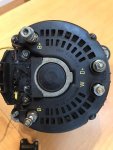shaula
Member
I have an early universal advanced regulator which I am fitting to my Volvo 2030 which has a standard Valeo regulator. According to the instructions, I have removed the alternator to solder 2 wires to the existing brush connections which allows a test to be carried out to determine if the existing alternator is positive or negative rotor. After removing the end cover I find that there are three wire terminals. Sterling have advised me that they can not advice on alternator questions. My questions are:



What 2 terminals do I connect too? See 3 soldered wires on left of photo.
Do the brushes actually have to be removed ? I assume another section of the alternator has to be removed to achieve this?
Are the standard Volvo/Valeo alternators negative, so does it really need the test connections to be made?




What 2 terminals do I connect too? See 3 soldered wires on left of photo.
Do the brushes actually have to be removed ? I assume another section of the alternator has to be removed to achieve this?
Are the standard Volvo/Valeo alternators negative, so does it really need the test connections to be made?
